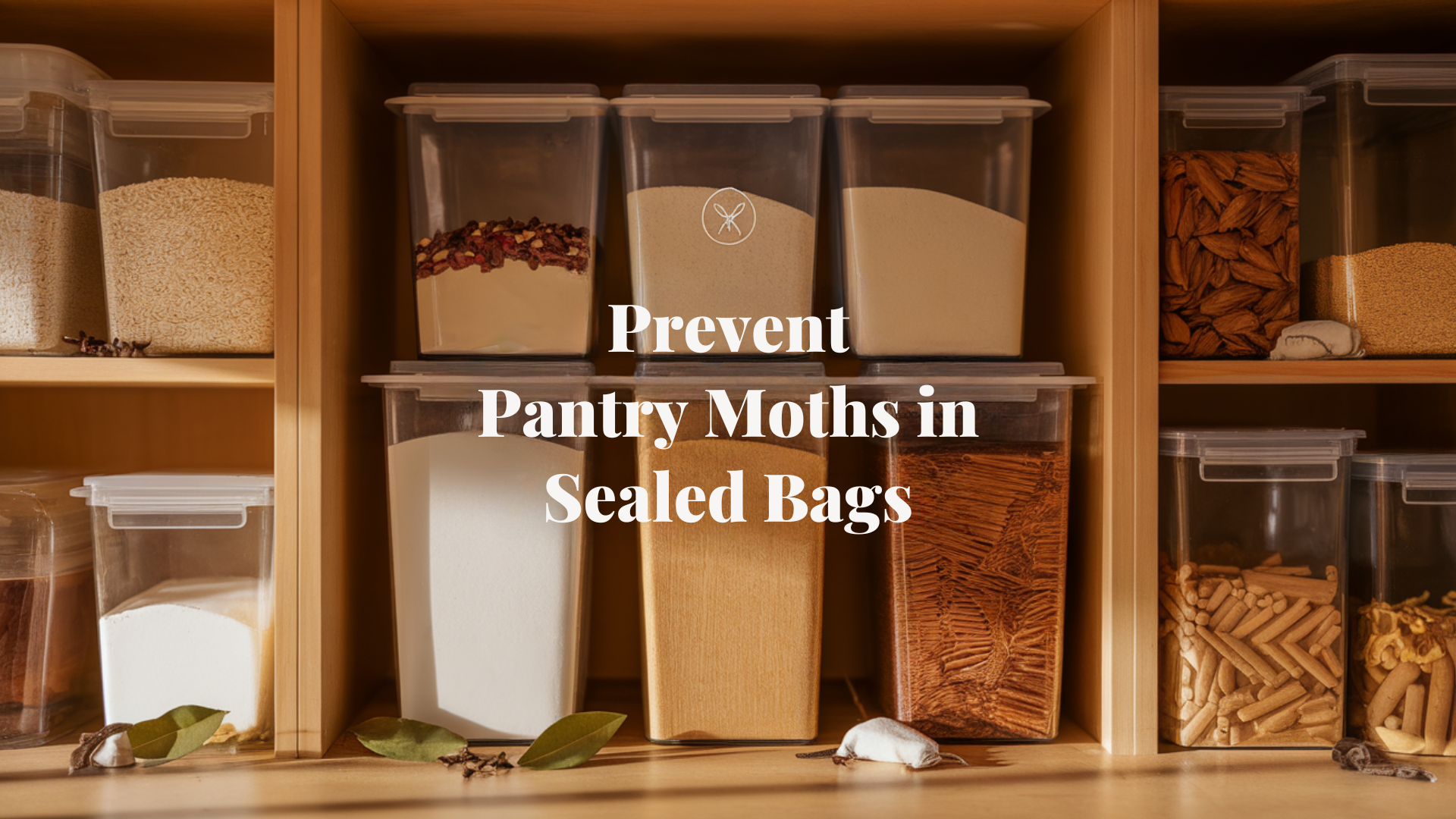Ever opened your pantry and spotted tiny moths flying around your food? You’re not alone. Pantry moths are one of the most frustrating—and surprisingly common—household pests. They seem to appear out of nowhere.
Even worse, they can get into everything from grains and cereals to nuts, flour, and even chocolate. The tricky part is how easily they invade sealed bags and boxes. They often leave behind webbing, larvae, or damaged food.
It’s not just gross—it’s also wasteful and expensive. If you’ve ever thrown out a full shelf of dry goods, you know how discouraging it feels.
In this guide, I’ll break down how pantry moths sneak into your food supply. More importantly, I’ll show you how to keep them out for good.
With a few smart storage upgrades and some simple habits, you can protect your pantry staples. You’ll also reduce the chance of dealing with infestations in the future.
I’ve faced pantry moths three times in my own kitchen. After lots of trial and error, I’ve learned what actually works—and what doesn’t.
If you’re currently battling a moth problem or trying to avoid one, these tips will help. They’ll guide you toward a pantry that stays clean, organized, and pest-free.
Understanding Pantry Moths
Pantry moths, also known as Indian meal moths, are common household pests. They sneak into homes through infested food products from grocery stores.
Once inside, they multiply quickly. A female moth can lay hundreds of eggs in her short lifetime. These eggs hatch into hungry larvae that feed on your stored foods.
The moths target pantry staples like flour, rice, cereal, pasta, dried fruits, nuts, and even pet food. Their life cycle includes four stages: egg, larva, pupa, and adult moth.
The larvae do the most damage. They contaminate food with webbing, droppings, and shed skins. Adult moths don’t actually eat—they just mate and lay more eggs.
What makes them hard to control is their size. The eggs are nearly invisible to the naked eye. By the time you notice adult moths flying around, you likely have a full infestation underway.
Why Sealed Bags May Not Be Enough?
Pantry moths often get in through weak spots in packaging. Many food bags and boxes seem sealed, but they aren’t always secure.
Thin materials like plastic or cardboard can be chewed through. Tiny gaps along seams may be enough for pests to slip in unnoticed.
In some cases, the infestation starts before the food enters your home. Moth eggs are extremely small and easy to miss.
These eggs can be present during food production, storage, or transport. Once inside your pantry, they hatch and spread in the warm indoor environment.
The problem doesn’t always stay in one package. Larvae can crawl between items, especially if they’re stored close together.
Even a few crumbs between packages can support them. This helps the infestation grow and reach more of your food supply.
Preventive Measures to Keep Moths Out
The best way to deal with pantry moths is to stop them before they start. Simple habits and smart storage choices can go a long way in keeping your food safe.
These preventive measures help create an environment that’s less inviting—and much harder—for moths to invade.
1. Proper Storage Solutions
How you store your food makes a big difference in preventing pantry moths. Even sealed packaging isn’t always enough on its own.
Using the right containers and organizing your pantry with care can help protect your food from pests and keep everything fresher, longer.
Airtight Containers
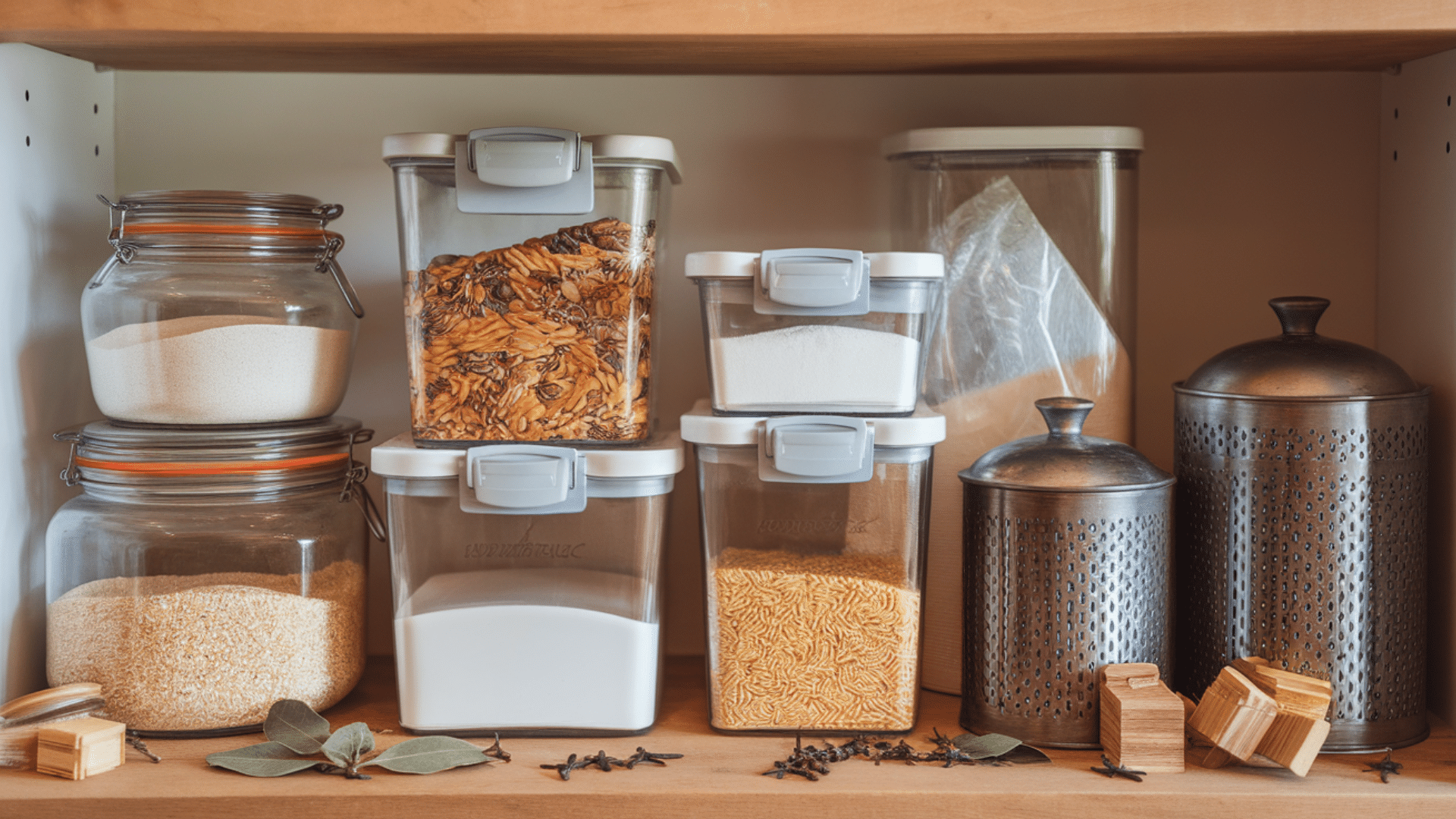
Glass containers with rubber gasket seals offer the best protection. Their hard surface can’t be chewed through by moth larvae. The clear sides let you easily spot any activity inside.
Heavy-duty plastic containers work well too. Look for those specifically designed for food storage with locking lids. These create a physical barrier moths cannot penetrate.
Metal canisters provide excellent protection. Their tight-fitting lids keep pests out completely. Many come in decorative designs that look nice on shelves.
Transfer foods from original packaging immediately after purchase. This stops any potential infestations from spreading. Label each container with contents and purchase date.
Vacuum Sealed Bags
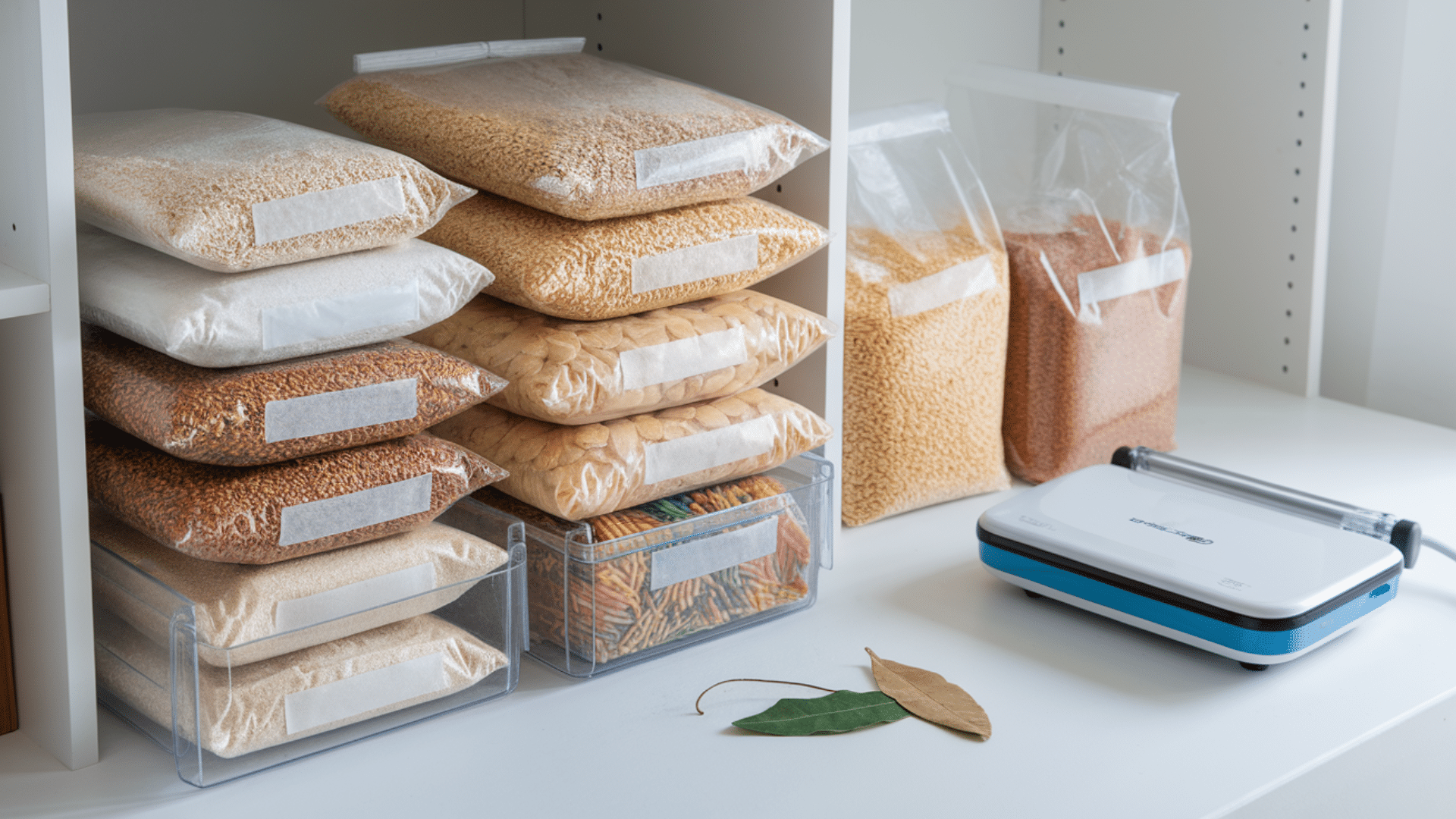
Vacuum sealing removes air that moths need to survive. This method is particularly effective for long-term storage of items like flour and rice.
Special vacuum seal bags are available for home use. They create an environment where eggs cannot hatch and larvae cannot develop.
This method also extends the shelf life of your foods. It prevents oxidation that can make items stale. Consider investing in a vacuum sealer for frequently stored items.
Double Sealing
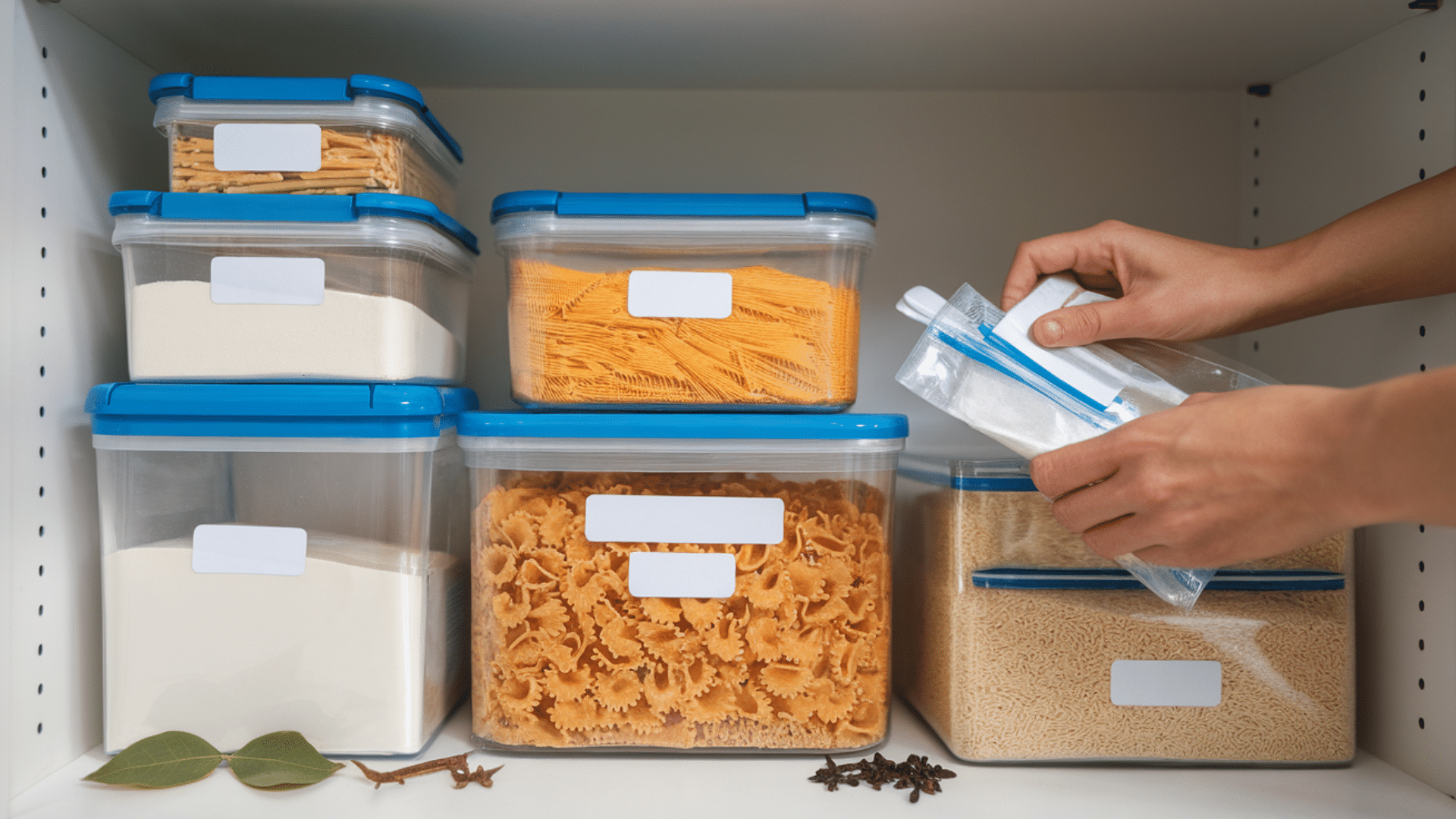
Keep items in their original packaging for convenience. Then place them inside a second sealed container for added protection.
This two-layer approach provides backup if one seal fails. It’s especially useful for items you don’t use frequently.
Zip-top freezer bags make good secondary containers. They’re inexpensive and easy to seal properly. Just squeeze out excess air before closing.
2. Regular Inspection and Cleaning
Keeping your pantry clean is one of the most effective ways to prevent infestations. Regular checks help you catch early signs of trouble before they spread.
A consistent cleaning routine also removes crumbs and spills that attract pests, making your pantry a less appealing place for moths to settle in.
Inspect New Purchases
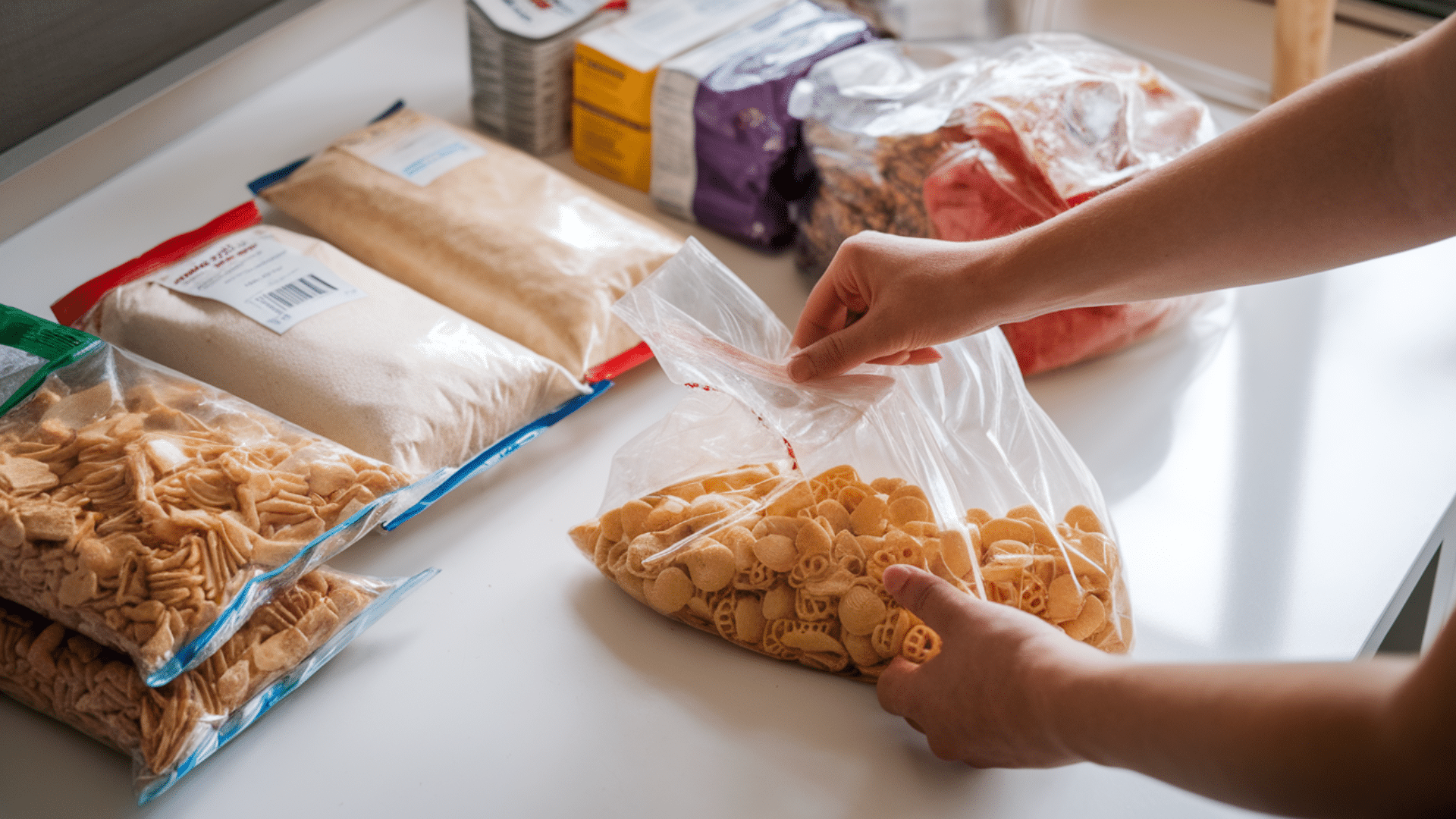
Before bringing groceries into your pantry, examine packaging carefully. Look for tiny holes, tears, or signs of webbing on the outside.
Pay special attention to package seams and folds. These are common entry points for moths and places where eggs might be hidden.
Check the expiration dates on all products. Older items have had more time to develop infestations. Consider freezing older stock before storing it.
If any package looks suspicious, place it in a sealed plastic bag. Keep it separate from other foods until you’re sure it’s pest-free.
Wipe Down Pantry Shelves

Clean your pantry shelves regularly with vinegar solution. This removes food particles that attract pests and eggs that might be present.
Pay special attention to corners and crevices. These hidden areas often harbor moths and larvae.
Remove all items from the shelves when cleaning. This gives you a chance to inspect each container. It also ensures no spots are missed during cleaning.
After wiping, allow shelves to dry completely before restocking. Moisture creates a welcoming environment for many pests including moths.
Vacuum and Disinfect

Use your vacuum’s hose attachment to reach cracks and corners. The suction can remove eggs and larvae too small to see.
Empty the vacuum bag or container outside immediately after use. This prevents any captured pests from escaping back into your home.
Follow vacuuming with a natural disinfectant spray. A mixture of white vinegar, water, and essential oils works well. The scent deters moths while sanitizing surfaces.
Repeat this deep cleaning process every few months. Regular maintenance prevents small problems from becoming major infestations.
3. Temperature and Environment Control
Pantry moths thrive in warm, humid environments. Managing the temperature and airflow in your storage areas can make a big difference.
By keeping conditions cool, dry, and well-ventilated, you create a space that’s much less inviting for pests to live and breed.
Keep the Pantry Cool and Dry

Maintain pantry temperatures below 70°F when possible. Moths thrive in warm environments and reproduce more quickly in heat.
Use a dehumidifier if your kitchen tends to be humid. Low humidity makes your pantry less hospitable to moths and other pests. Consider storing particularly vulnerable items like flour in the refrigerator. The cold temperature prevents eggs from hatching.
Monitor your pantry environment with an inexpensive temperature and humidity gauge. This helps you maintain optimal conditions.
Use Airtight Containers in The Fridge or Freezer
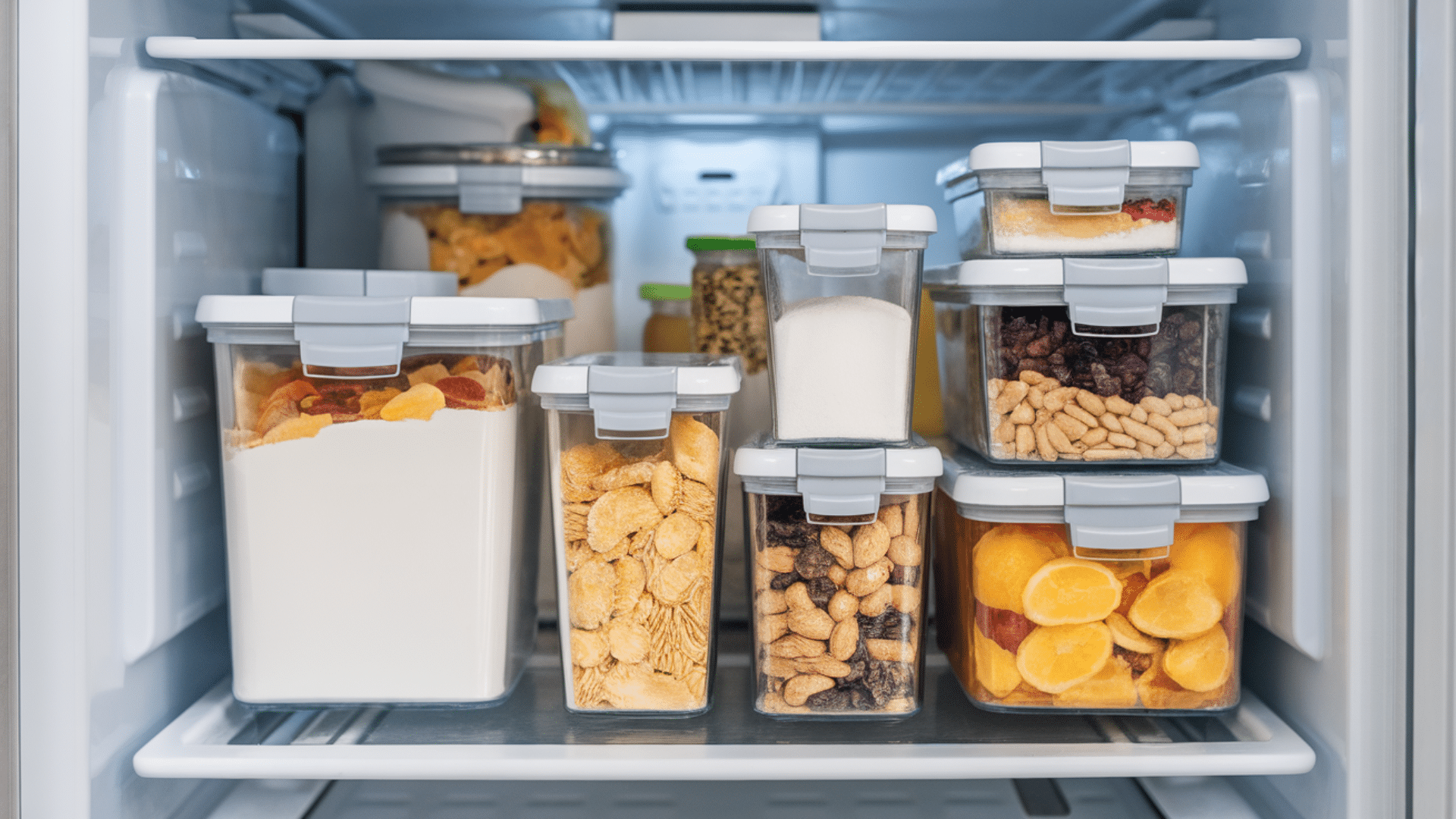
Freezing new dry goods for 72 hours kills any existing eggs or larvae. After freezing, transfer items to airtight containers before returning them to the pantry.
The refrigerator offers similar protection for frequently used items. Keep flours, nuts, and dried fruits in the fridge if you have space.
Even when refrigerating or freezing, use proper containers. This prevents moisture absorption and odor transfer between foods.
Rotate your stock regularly, using older items first. This prevents food from sitting untouched for long periods where infestations can develop unnoticed.
Ensure Proper Ventilation

Install a small fan if your pantry lacks air circulation. Moving air makes it harder for moths to land and lay eggs. Leave space between containers rather than crowding them together. This improves airflow and makes it easier to spot any pest activity.
Consider leaving the pantry door open occasionally. This allows fresh air to circulate and disrupts the ideal breeding conditions moths prefer.
Check ventilation grills or ducts leading to your pantry. These can be entry points for pests if not properly screened or maintained.
4. Natural Deterrents
If you prefer chemical-free solutions, natural deterrents can help keep pantry moths away. Certain scents and ingredients are known to repel these pests.
When used correctly, these simple, non-toxic methods add an extra layer of protection without affecting your food
Bay Leaves and Cloves
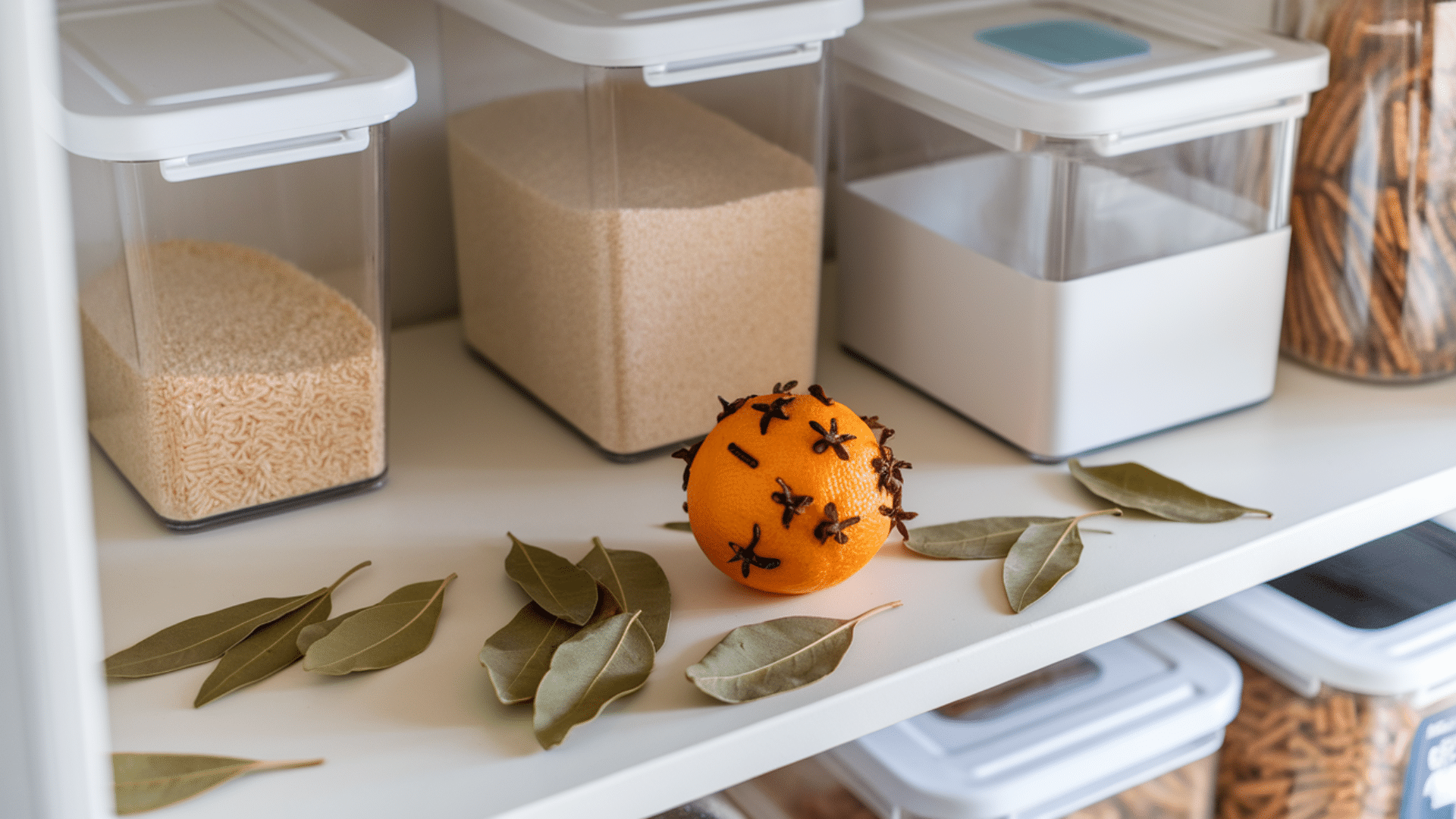
Place whole bay leaves on pantry shelves. Moths dislike their scent and tend to avoid areas where they’re present. Refresh these natural repellents every few months. Their effectiveness decreases as the scent fades.
Stick whole cloves into an orange or lemon for a decorative and effective deterrent. The strong smell repels moths while adding a pleasant aroma to your pantry.
These natural options are safe around food and won’t contaminate your supplies. They’re an excellent supplement to other prevention methods.
Cedar Wood Blocks
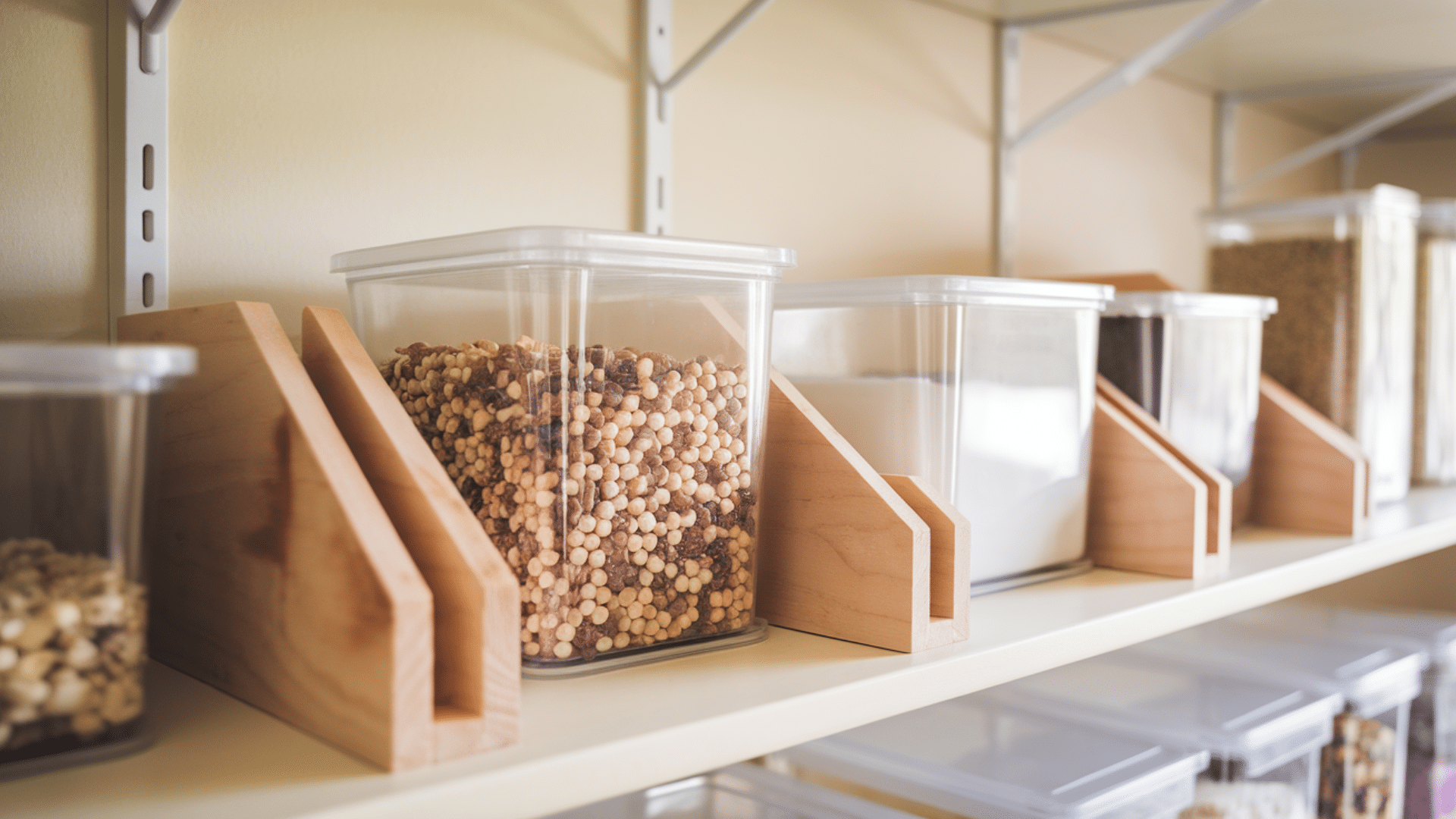
Place cedar blocks or chips on pantry shelves. Cedar naturally repels many insects including moths. The wood releases oils that insects find offensive. These oils also absorb moisture which further deters pests.
Sand cedar blocks lightly when their scent fades. This exposes fresh wood and renews the repellent properties. Cedar is completely natural and food-safe. It adds a pleasant aroma to your pantry while keeping pests at bay.
Essential Oils
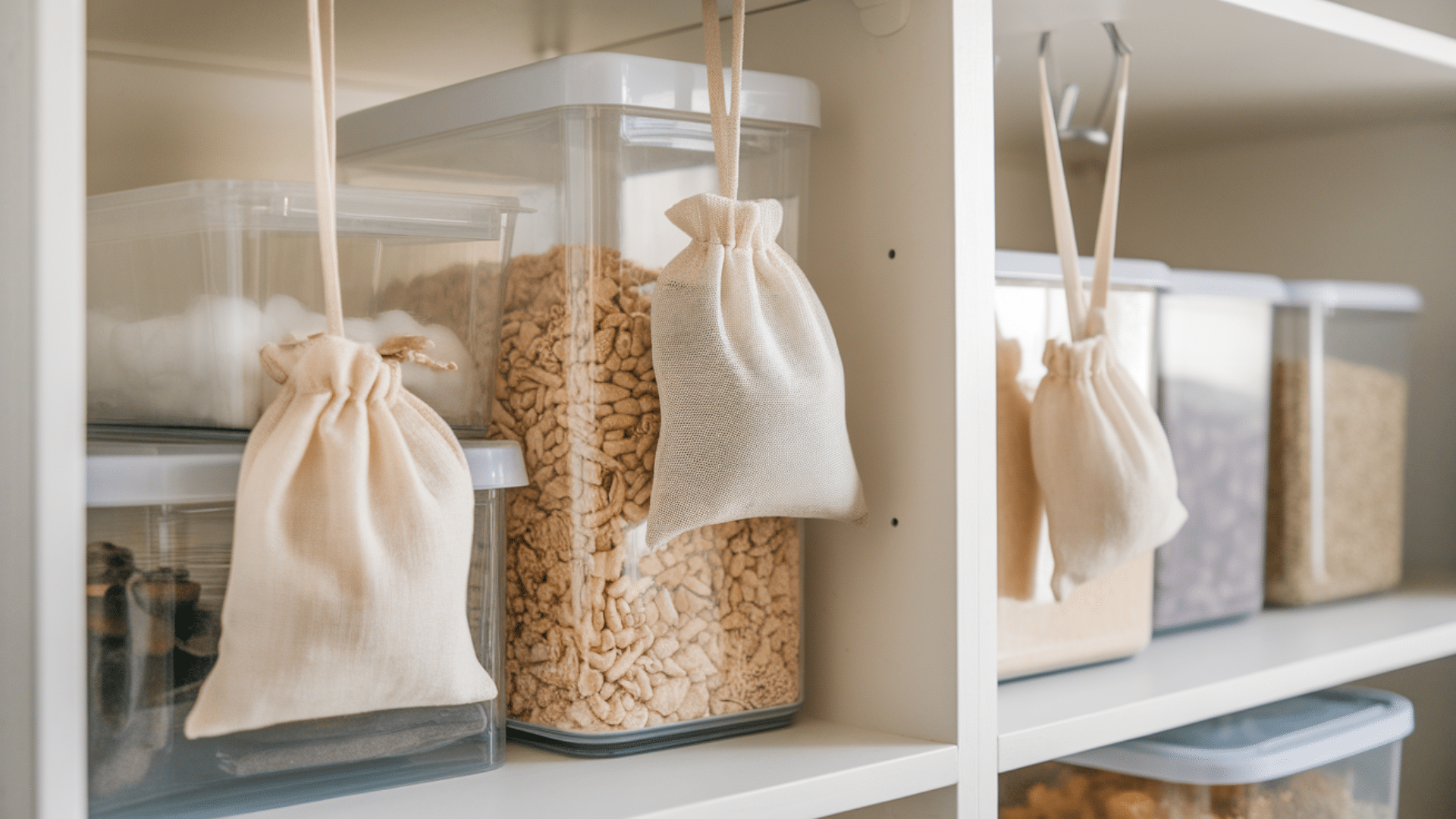
Create sachets with cotton balls soaked in essential oils. Peppermint, lavender, eucalyptus, and tea tree oils are particularly effective.
Place these sachets between containers or hang them in corners. Replace them monthly to maintain effectiveness.
You can also add a few drops of essential oil to your cleaning solution. This leaves behind a residual scent that continues to deter moths. These oils are natural but powerful. Use them sparingly around foods that might absorb odors.
What to Do if You Spot Moths?
If you see moths flying in your pantry, act quickly. Adult moths indicate an active infestation is underway. Remove all items from your pantry for thorough inspection. Discard any products showing signs of infestation like webbing or larvae.
Place potentially contaminated items in the freezer for at least four days. This kills any eggs or larvae that might be present.
Vacuum all surfaces including walls, ceiling, and floor. Pay special attention to corners, cracks, and the underside of shelves. Wash all surfaces with hot, soapy water. Follow with a vinegar solution to disinfect and deter future infestations.
Consider using pheromone traps to catch male moths. These won’t eliminate an infestation but help monitor its severity and track your progress.
Keep your pantry empty for several days if possible. This breaks the life cycle of any remaining moths. Remain vigilant after cleaning. Check for signs of reinfestation regularly over the next few months.
Conclusion
Maintaining a moth-free pantry takes more than just using sealed bags. It requires a combination of habits and smart choices.
Using proper storage containers is a great first step. Cleaning regularly and keeping your pantry dry and cool also helps. Adding natural deterrents can offer extra protection.
Remember, prevention is much easier than dealing with a full infestation. Take a moment to inspect new food items before storing them. Transfer everything into airtight containers as soon as you get home.
These small habits go a long way. They save you from the stress and waste that come with moth problems. With consistent effort, you can keep your pantry clean and pest-free all year long.
I’ve been using these methods in my own home for years. They work. The upfront cost of good storage containers is worth it. You’ll save money, time, and food in the long run.
Have you faced pantry pest challenges? Share your experiences or questions in the comments below!

